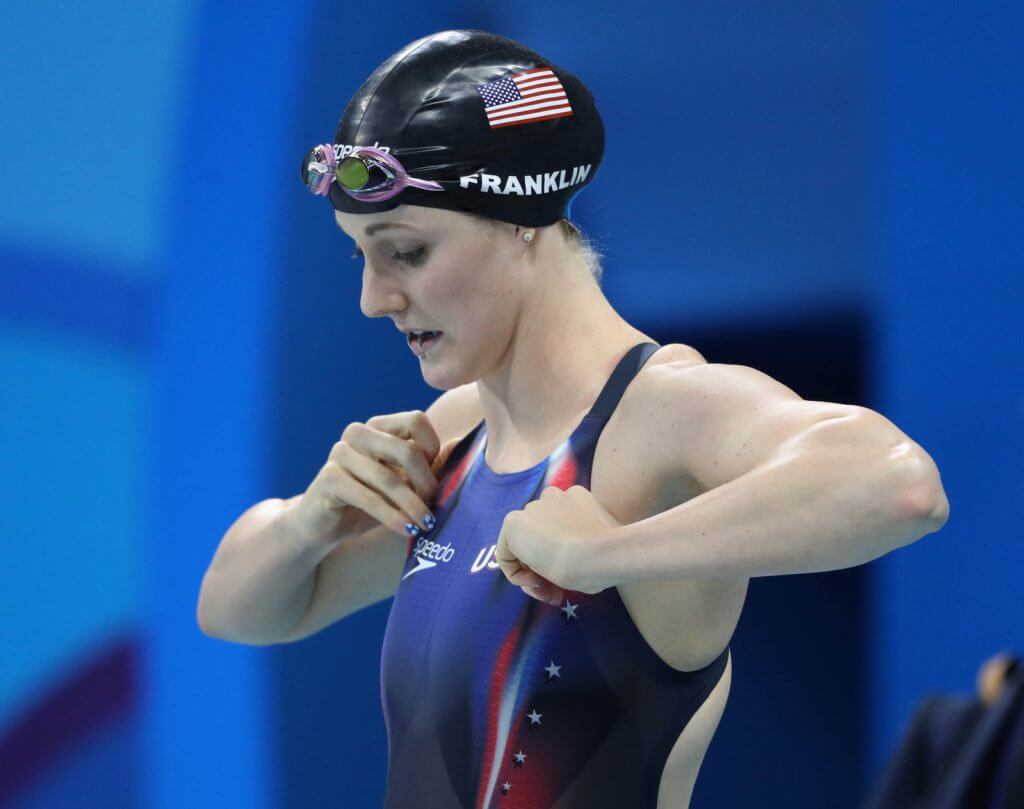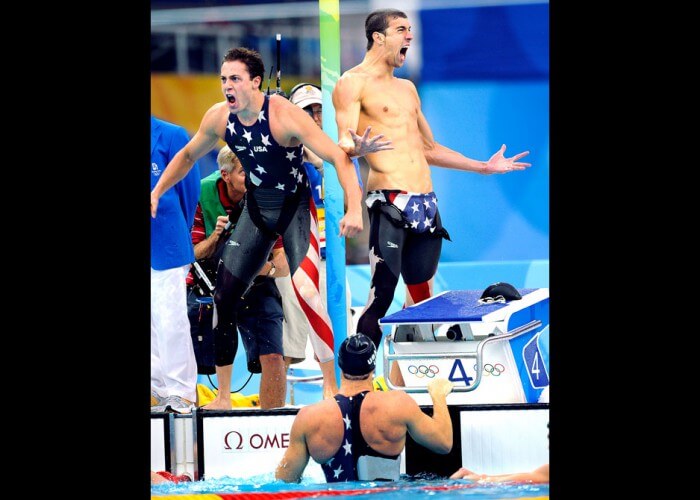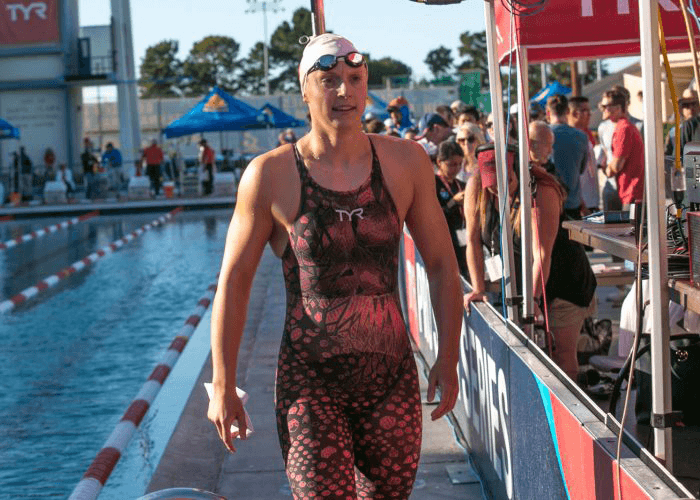One Decade Later, Do We Miss the Full-body Tech Suit?

By Lianne McCluskey, Swimming World Intern.
It has been one decade since FINA banned the now infamous tech suit and ended the “shiny suit era” – one in which the world saw records falling at an alarming rate. In an article written by the late Steve Connor in The Independent (see link at bottom of article), experts warned that world records would unlikely be broken for decades after they were banned in 2009. Reflecting on this monumental part of swimming history elicits this question: Where are we today?

Photo Courtesy: Delly Carr/Swimming Australia Ltd.
In order to answer that question, we must dig into the past. The tech suit revolution really took hold following the 2004 Olympics when Speedo asked NASA to help design a competition suit that would reduce drag. Through their partnership came the creation of the full-body LZR Racer. The suit could be either full-length, knee-length or shorter. With ultrasonically welded seams and a zipper, the suit compressed a swimmer’s body into a streamlined tube that sometimes trapped air, adding buoyancy and reducing drag. Through the use of polyurethane material, the suit was designed to also make swimmers more hydrodynamic.
Within a year of its release in early 2008, the LZR Racer achieved worldwide fame, highly believed to be the most successful swimsuit ever made. Within a month, athletes wearing the suit broke 13 world records. At the 2008 Summer Olympics in Beijing, according to SpeedoUSA, 98 percent of medal winners in swimming competitions won while wearing a LZR Racer. Out of the 25 world records broken at that Olympics, 23 were accomplished by swimmers wearing the suit. Michael Phelps set world marks in seven of his eight events at Beijing wearing a version of the suit but not the full-body.

Photo Courtesy: Wally Skalij
In response to the demand, companies such as TYR, Arena, BlueSeventy and more began creating wetsuit-like neoprene suits (shiny suits) after the 2008 Beijing Olympics, which ultimately led to a ban of the LZR Racer and the emerging class of shiny suits among all brands.
Beginning in 2010, the new rules permit only “jammers” – suits from the kneecap to navel for men and from the knee to shoulder for women. The fabric must be air permeable, and a suit may not have any fastening devices such as a zipper. Speedo has since developed a new line of LZR suits that comply with FINA’s new regulations, and other swim brands have also designed popular competition suits that comply with established rules.
In response to the ban, Professor Steve Haake, director of the Centre for Sports Engineering Research at Sheffield Hallam University stated that “a ban on swimsuits has created an insurmountable rift in performance at the highest levels of the sport.” He also commented that elite swimmers are at a disadvantage without the suit, and that we may not see world records be broken for decades.
So after one decade, how close have we gotten to rewriting the records set with these “super-suits”?

Photo Courtesy: JD Lasica
Katie Ledecky’s legendary performances alone have shown that the suit doesn’t make the swimmer, and the majority of women’s world records have been broken since 2009. On the men’s side, though, it may be a few years before we see the historic relay of Michael Phelps, Garrett Weber-Gale, Cullen Jones, and Jason Lezak erased from the record books; however, records are falling every year in individual events. You can find current Long Course Meter World Records by following this link to Swimming World’s website. FINA also provides 25m World Records.
Another exemplary swimmer is Caeleb Dressel. Following his 2018 NCAA success, Swimming World evaluated the likelihood of him matching eight gold medals at Tokyo 2020. Currently, he is only .04 off of Phelps’ signature 100 butterfly world record, a record Phelps spent years trying to steal away from butterfly legend Ian Crocker. Regardless of whether or not he will be able to do so, Dressel not only has set American records in the sprint freestyle and butterfly events but also demonstrated his record-setting capabilities at the 2018 SEC Championships, where he surpassed David Nolan’s US Open, NCAA and American records with a time of 1:38.13 in the 200 IM. He also broke the NCAA and American record in the 100 breaststroke with a time of 50.03.

Photo Courtesy: SIPA USA
Other notable world record holders following the FINA ban on the full-body suits include the following swimmers:
Men’s LCM world records broken since 2009:
- Adam Peaty (GBR) – 50, 100 breaststroke
- Ryan Lochte (USA) – 200 IM
- Andriy Govorov (UKR) – 50 butterfly
- Ryan Murphy (USA) – 100 backstroke
- Kliment Kolesnikov (RUS) – 50 backstroke
- Yang Sun (CHN) – 1500 freestyle
- Ippei Watanabe (JPN) – 200 breaststroke
Women’s LCM world records broken since 2009:
- Sarah Sjöström (SWE) – 50 & 100 freestyle, 100 fly
- Katinka Hosszu (HUN) – 200, 400 IM
- Katie Ledecky (USA) – 400, 800, 1500 freestyle
- Kathleen Baker (USA) – 100 backstroke
- Missy Franklin (USA) – 200 backstroke
- Lilly King (USA) – 50, 100 breaststroke
- Rikke Moeller-Pedersen (DEN) – 200 breaststroke
- AUS – Shayna Jack, Bronte Campbell, Emma McKeon, Cate Campbell – 400 freestyle relay
- USA – Kathleen Baker, Lilly King, Kelsi Worrell, Simone Manuel – 400 medley relay
Where There is a Will, There is a Way
It’s safe to say never underestimate human ability, persistence, and the drive to achieve and be the best. Though it can be argued that the ban on the full-body competition suits has slowed down the rate of world records being broken, one things is certain: with or without them, we are capable of re-writing the record books. For a deeper analysis of progress since the ban of these “super-suits,” check out Swimming World‘s story here: Can World Records Supersede the Super-Suit era?
All commentaries are the opinion of the author and do not necessarily reflect the views of Swimming World Magazine nor its staff.




Do you mean the full body girdle that cost $500, takes 15-20 minutes to get into, and if your chest is 50+, you’re kinda screwed anyway? Na, I’m okay without it…
Today’s suits take about 10-15 minutes to get into and are quite extensive too ? but i prefer these ones
Jim Pogue suits now are in the same $ range and can take 30 min to get into with teammates stuffing your parts into it for you.
Jim Pogue if your race suit doesn’t take 30+ minutes to get into you aren’t wearing the right size suit bud ??
Charlotte Cusachs Bujoreanu you’ve been buying the wrong suits man ??
Bruno Fratus we have to buy the suits the team requires, not a choice.
I miss the leg skin for the men’s suits. Those were awesome
Karen Diamond Eckhart
One thing missing in the article: Caeleb Dressel’s 1:38.13 was in the 200 IM.
William Gettings
No. Swimming became more about the suit and less about the swimmer inside of it and how much they trained.
Fahq NO!!!
No!!!
Since I could never afford more than a fastskin jammer in the Tech suit era, not really missing them too much.
Hell no!!! It was freaking long time to get into?
No!
I still have my full body suit from college. It was the 1st variation of the fastskin. I also have the FSII full leg suit from 2007’s master’s state.
Nobody misses spending an hour putting on a suit.
No
It was the ultimate teammate bonding product!
No!
It would be interesting to see a study done on average high level swim times with and without the tech suits. There will always be extraordinary performers who break records, but did the tech suits lower times.. That is the question.